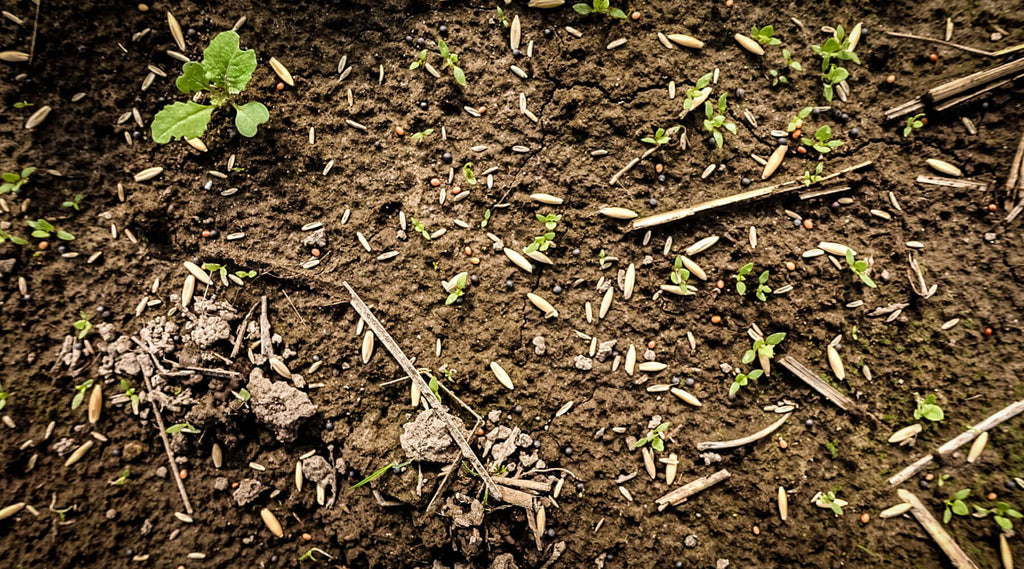
Fixing Food Plot Failures
5 min read
If you've turned a hand-crank on a broadcaster, driven a tractor or prayed for rain, you've probably experienced food plot failure like the rest of us. It happens. In fact, as the number of acres of new food plot forages and latest and greatest food plot blends continues to grow, so will the number of acres of food plot fails. Are your plots down to the dirt, plagued by weeds or doomed by drought? Don't worry; you and the local deer herd still have time to enjoy fields of food plot green. Here are three ways to make it happen!
Weeds Killed and Forage Growing
While working with small parcel hunters, readers, and viewers across the northern half of the country, nothing bothers me more when it comes to food plotting than weedy fields. Whatever the percentage of food plot acres that you have where weeds have taken over is the percentage of acres you lose for building a quality herd and hunt. When parcel sizes and food plot acres are small, you can't afford to lose your food plot efficiency to the grasses and broadleafs that often invade your food plot. This is when it is time to get tough!
Missed opportunities are found when weeds are allowed to flourish.
My favorite food plot salvage when weed populations are high accomplishes two things: dead weeds and green food plots. As long as sufficient soil is exposed for seed-to-soil contact, you can spread Winter Rye at varying rates to save your food plot.
For late summer salvage seeding rates, I focus on 100-150 pounds per acre of seed 4-6 weeks before your typical first frost, 150-200 pounds per acre of seed 2-4 weeks prior and up to 300 pounds of seed up to two weeks before your first frost. Your goal is to carpet the soil with a lush green foliage and Winter Rye is the most cold hardy, soil and ph tolerant forage that you can plant. However, broadcasting Winter Rye is only the first step!
After your Winter Rye seed has been broadcasted, it is time to spray the weed growth with two quarts per acre of Glyphosate. Glyphosate is a post-emergent herbicide and will not harm the seed lying on the ground within the weeds. There is no need to disc, till or drag, just simply broadcast the rye, spray and enjoy the season.
It is key to remember that food plotting is not farming. What that means is that since you are not producing seed head production the following summer, much greater varying seeding rate of rye can be appropriate, as determined by your local first-frost date.
Brassica Crop Failure Broadcasting

Winter Rye food plot salvages can take place right until your expected first frost and even a little later. During the early 2000’s, a Winter Rye broadcasting of mine was germinated by the five inches of melting snow following an October 1st storm. Winter rye is the most cold hearty forage variety and can germinate in soil temperatures in the high 30’s. However, even though brassica forages need to be planted up to ten weeks before the first frost, there are options that you can practice much earlier if you keep a more watchful eye on your food plot.
Has drought or weeds ravaged your brassica plot within 2-3 weeks of your planting? Then plant again. The most appropriate planting timing for a brassica crop is roughly ten weeks before your expected first frost. With a ten week window, you still have time for an adequate food plot salvage.
Most potential weed or drought problems take place during the first two weeks of a brassica planting. A lack or rain destroys seed and a lack of attention to adequate weed control measures before your planting allows weeds to outcompete young growth. If you attack it early, a brassica food plot save is fairly easy! If your resources allow you to do so, simply repeat the planting process if weeds are flourishing and no growth (including weeds) has taken place in the first two weeks. Simply broadcast, spray and enjoy your plot if you are still 7-8 weeks away from your expected first frost. You can even resort to Winter Rye salvage efforts if the first frost date is looming more closely on the calendar.
If you can help it, don't miss out on the earlier opportunities to replant your intended brassica crop.
Over-browsed Food Plot Makeovers

The ways for a food plot to fail are many. Whitetails may be as much to blame as weeds and drought. One of the first ways to cure a potential plot from overbrowsing is by planting the right forage for the conditions. For example, crops like corn and soybeans need to be planted in amounts of five acres or more if they are to withstand even moderate browsing opportunities. Plantings that lack the support of surrounding agricultural plantings or other high quality destination food sources will attract a much greater percentage of a whitetails’ overall daily diet.
If you expect your plot to last more than a few weeks into the hunting season, choosing the right forage based on your local habitat conditions is the first step. However, when all else fails, it is time to rely on seed varieties that are easy to germinate and grow following a simple hand broadcasting.
During the summer of 1995, I planted my first food plot. In 2005, I began teaching clients about surefire food plot tactics. By 2014, I published my first book about advanced food plot strategies. After working directly with nearly 600 clients in twenty-one states to implement highly successful food plot strategies on the lands they hunt, there is one food plot "sin" that I can't stand: empty exposed fall soil.
There is no need to take a forage-less food plot into the hunting season and an overbrowsed food plot is no exception. Broadcasting brassica, Winter Rye or both into your field of stubble can be a surefire way to experience beautiful fields of green during the hunting season. Do you have raccoon-infested corn or whitetail ravaged beans? Use the window of opportunity during late July through early September to broadcast a solid offering of food plot salvage varieties to strengthen your food plots. You may find that the new young growth within your initial plot takes some pressure off of the overbrowsed species. If you are still seven to eight weeks away from your expected first frost date, you can utilize a quality brassica blend. If frost is just around the corner, Winter rye can be a solid answer for you.
Salvaging a Food Plot

Try turning food plot junk into beauty by blending the old forage failure with surefire salvage methods.
Throughout the last 20+ years of developing food plot strategies for my career and my personal whitetail hunting activities, one of my greatest teachers has been failure. If you haven't experienced over-browsed, drought stricken or weed infested fields yet, sometimes all at once, your day is likely coming. However, when that day comes, don't feel the need to give up!
Successful food plotting isn't about choosing the latest and greatest seed blend and getting it to grow because often you may be setting yourself up for failure before you even open the bag. Instead, you will find success when you choose surefire, adequate seed blends that can work for you when you and the local herd need them most. When all else fails, and it eventually will, consider the appropriate use of Winter rye or brassica broadcastings, herbicide treatments and overseeding makeovers to ensure that any fall plot failures have the potential to find green success.
Leave a comment
Comments will be approved before showing up.

